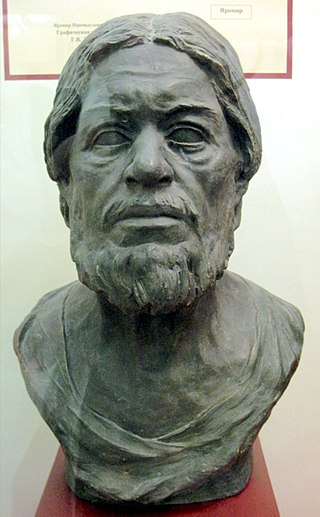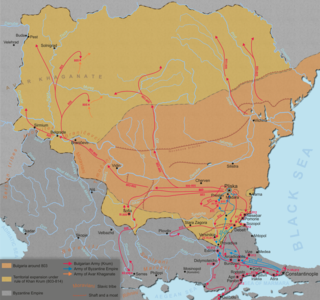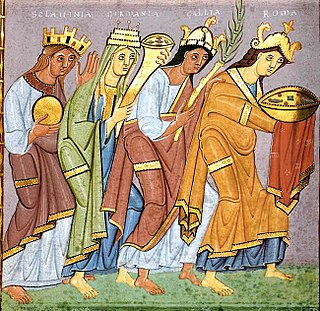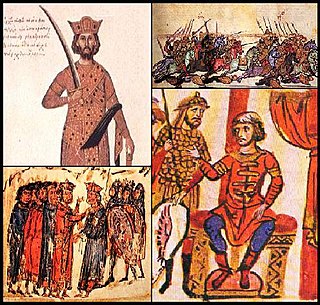Related Research Articles
The 810s decade ran from January 1, 810, to December 31, 819.

813 (DCCCXIII) was a common year starting on Saturday of the Julian calendar, the 813th year of the Common Era (CE) and Anno Domini (AD) designations, the 813th year of the 1st millennium, the 13th year of the 9th century, and the 4th year of the 810s decade. As of the start of 813, the Gregorian calendar was 4 days ahead of the Julian calendar, which was the dominant calendar of the time.

Samuel was the Tsar (Emperor) of the First Bulgarian Empire from 997 to 6 October 1014. From 977 to 997, he was a general under Roman I of Bulgaria, the second surviving son of Emperor Peter I of Bulgaria, and co-ruled with him, as Roman bestowed upon him the command of the army and the effective royal authority. As Samuel struggled to preserve his country's independence from the Byzantine Empire, his rule was characterized by constant warfare against the Byzantines and their equally ambitious ruler Basil II.

Leo IV the Khazar was Byzantine emperor from 775 to 780 AD. He was born to Emperor Constantine V and Empress Tzitzak in 750. He was elevated to co-emperor in the next year, in 751, and married to Irene of Athens in 768. When Constantine V died in September 775, while campaigning against the Bulgarians, Leo IV became senior emperor. In 778 Leo raided Abbasid Syria, decisively defeating the Abbasid army outside of Germanikeia. Leo died on 8 September 780, of tuberculosis. He was succeeded by his underage son Constantine VI, with Irene serving as regent.
Kaloyan or Kalojan, also known as Ivan I, Ioannitsa or Johannitsa, the Romanslayer, was emperor or tsar of Bulgaria from 1196 to 1207. He was the younger brother of Theodor and Asen, who led the anti-Byzantine uprising of the Bulgarians and Vlachs in 1185. The uprising ended with the restoration of Bulgaria as an independent state. He spent a few years as a hostage in Constantinople in the late 1180s. Theodor, crowned Emperor Peter II, made him his co-ruler after Asen was murdered in 1196. A year later, Peter was also murdered, and Kaloyan became the sole ruler of Bulgaria.

Krum, often referred to as Krum the Fearsome was the Khan of Bulgaria from sometime between 796 and 803 until his death in 814. During his reign the Bulgarian territory doubled in size, spreading from the middle Danube to the Dnieper and from Odrin to the Tatra Mountains. His able and energetic rule brought law and order to Bulgaria and developed the rudiments of state organization.

Byzantine Greece has a history that mainly coincides with that of the Byzantine Empire itself.

The Battle of Pliska or Battle of Vărbitsa Pass was a series of battles between troops, gathered from all parts of the Byzantine Empire, led by the Emperor Nicephorus I, and the First Bulgarian Empire, governed by Khan Krum. The Byzantines plundered and burned the Bulgar capital Pliska which gave time for the Bulgarians to block passes in the Balkan Mountains that served as exits out of Bulgaria. The final battle took place on 26 July 811, in some of the passes in the eastern part of the Balkans, most probably the Vărbitsa Pass. There, the Bulgarians used the tactics of ambush and surprise night attacks to effectively trap and immobilize the Byzantine army, thus annihilating almost the whole army, including the Emperor. After the battle, Krum encased the skull of Nicephorus in silver, and used it as a cup for drinking. This is one of the most documented instances of the custom of the skull cup.

Ivan Asen I, also known as Asen I or John Asen I, was emperor or tsar of Bulgaria from 1187/1188 to 1196 as co-ruler with his elder brother, Peter II. Hailing from the Byzantine theme of Paristrion, his exact place and date of birth are unknown. Most contemporaneous chronicles describe Asen and his brothers, Theodor (Peter) and Kaloyan, as Vlachs but they were probably of mixed Bulgarian, Cuman and Vlach ancestry.

Boril was the emperor (tsar) of Bulgaria from 1207 to 1218. He was the son of an unnamed sister of his predecessor, Kaloyan and Kaloyan's brothers, Peter II and Ivan Asen I, who had restored the independent Bulgarian state. After Kaloyan died unexpectedly in October 1207, Boril married his widow, a Cuman princess and seized the throne. His cousin, Ivan Asen, fled from Bulgaria, enabling Boril to strengthen his position. His other kinsmen, Strez and Alexius Slav, refused to acknowledge him as the lawful monarch. Strez took possession of the land between the Struma and Vardar rivers with the support of Stefan Nemanjić of Serbia. Alexius Slav secured his rule in the Rhodope Mountains with the assistance of Henry, the Latin Emperor of Constantinople.

The First Bulgarian Empire was a medieval state that existed in Southeastern Europe between the 7th and 11th centuries AD. It was founded in 680–681 after part of the Bulgars, led by Asparuh, moved south to the northeastern Balkans. There they secured Byzantine recognition of their right to settle south of the Danube by defeating – possibly with the help of local South Slavic tribes – the Byzantine army led by Constantine IV. During the 9th and 10th century, Bulgaria at the height of its power spread from the Danube Bend to the Black Sea and from the Dnieper River to the Adriatic Sea and became an important power in the region competing with the Byzantine Empire.

The Battle of Versinikia was fought in 813 between the Byzantine Empire and the Bulgarian Empire, near the city of Adrianople (Edirne) in modern-day Turkey.

Peter II, born Theodor, also known as Theodor-Peter, was the first emperor or tsar of the restored Bulgarian Empire from 1185 to 1197. He hails from the Byzantine theme of Paristrion, although his exact place and date of birth are unknown.

The Sclaveni or Sklabenoi were early Slavic tribes that raided, invaded and settled in the Balkans in the Early Middle Ages and eventually became one of the progenitors of modern South Slavs. They were mentioned by early Byzantine chroniclers as barbarians having appeared at the Byzantine borders along with the Antes, another Slavic group. The Sclaveni were differentiated from the Antes and Wends ; however, they were described as kin. Eventually, most South Slavic tribes accepted Byzantine or Frankish suzerainty, and came under their cultural influences and Chalcedonian Christianity. The term was widely used as a general catch-all term until the emergence of separate tribal names by the 10th century.

The Byzantine–Bulgarian wars were a series of conflicts fought between the Byzantine Empire and Bulgaria which began after the Bulgars conquered parts of the Balkan peninsula after 680 AD. The Byzantine and First Bulgarian Empire continued to clash over the next century with variable success, until the Bulgarians, led by Krum, inflicted a series of crushing defeats on the Byzantines. After Krum died in 814, his son Omurtag negotiated a thirty-year peace treaty. Simeon I had multiple successful campaigns against the Byzantines during his rule from 893 to 927. His son Peter I negotiated another long-lasting peace treaty. His rule was followed by a period of decline of the Bulgarian state.

Much of the territory of the modern state of Serbia was part of the Roman Empire and later the Eastern Roman Empire. In particular, the region of Central Serbia was under Roman rule for about 800 years, starting from the 1st century BC, interrupted by the arrival of the Slavs into the Balkans during the 6th century, but continued after fall of the First Bulgarian Empire in the early 11th century and permanently ended with the rise of the Second Bulgarian Empire in the late 12th century. The territories were administratively divided into the provinces of Moesia, Pannonia and Dardania. Moesia Superior roughly corresponds to modern Serbia proper; Pannonia Inferior included the eastern part of Serbia proper; Dardania included the western part of Serbia proper. After its reconquest from the Bulgarians by Emperor Basil II in 1018, it was reorganized into the Theme of Bulgaria.

From c. 970 until 1018, a series of conflicts between the Bulgarian Empire and the Byzantine Empire led to the gradual reconquest of Bulgaria by the Byzantines, who thus re-established their control over the entire Balkan peninsula for the first time since the 7th-century Slavic invasions. The struggle began with the incorporation of eastern Bulgaria after the Russo-Byzantine War (970–971). Bulgarian resistance was led by the Cometopuli brothers, who – based in the unconquered western regions of the Bulgarian Empire – led it until its fall under Byzantine rule in 1018.
Kardam was the ruler of the First Bulgarian Empire.

Develtos or Deultum was an ancient city and bishopric in Thrace. It was located at the mouth of the river Sredetska reka on the west coast of Lake Mandrensko, previously part of the Gulf of Burgas, and near the modern village of Debelt.

The Martyrs of Adrianople, also known and venerated as the 377 Martyred Companions in Bulgaria, were three hundred and seventy seven Christians who were executed in martyrdom in 815. They are commemorated by the Eastern Orthodox Church on 22 January.
References
- 1 2 3 Curta (2006), pp. 150–151.
- 1 2 3 4 5 Sophoulis (2011), p. 222.
- ↑ Sophoulis (2011), p. 38.
- 1 2 3 4 Hupchick (2017), p. 92.